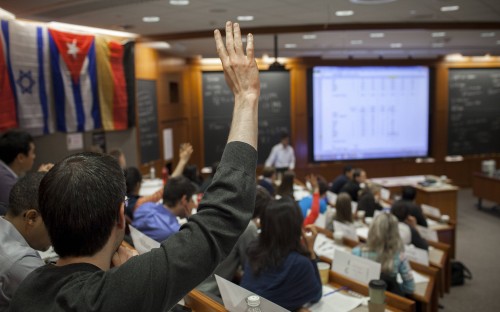The latest Tomorrow’s MBA report from CarringtonCrisp, a consultancy, and the EFMD management development network, polled 1,463 students from 75 countries. The study revealed that 27% prefer a full-time one-year MBA over a two-year one (25%).
There were regional differences. Students from the UK, Canada and Nigeria preferred the one-year format, while the two-year degree was wanted by students in the US, Germany, India and Indonesia.
Andrew Crisp, author of the study, said: “Globally, there are a number of reasons [why] the one-year, full-time MBA is growing in popularity.
“Careers and employment are changing rapidly, so students want to acquire new skills and achieve a return on their investment quickly."
The study is the latest evidence that the traditional, two-year MBA is waning in popularity. Recent data from the Graduate Management Admission Council (GMAC) found that only one-third (32%) of two-year programs in the US reported increased application volumes.
One reason for the fall is that students see cheaper courses as more attractive, as they can recoup their cost of tuition more quickly in the labor market. A two-year MBA at a top school can cost upwards of $200,000.
Business schools in Europe, Canada and Asia — where MBA programs are often around 12 months long — are likely profiting from the trend. A majority of business programs — including the MBA — in Europe, Canada, some parts of Asia, and India report growing application volumes, GMAC said.
To tempt students to expensive two-year courses, business schools are dolling out more scholarship cash. Some 61% of students are receiving scholarships based on merit or financial need, or both, in 2018, according to data from GMAC. That is up from 41% in 2014.
At Harvard Business School, more than half of the 900 MBA students will receive funding, with the average award slashing tuition to $35,000 from $72,000 a year, according to a report in the Wall Street Journal.
The MBA at ESADE Business School is usually completed in 18 months. Cristina Olabarría, director of admissions, said: “In recent years, ESADE has worked to raise funds that will allow us to provide more scholarships and financial aid to students.
“We have an extensive portfolio of scholarships that we award to the best candidates, regardless of their economic situation. We also put candidates in contact with banks and international organizations that offer scholarships and loans with very favourable conditions.”
Just over half (51%) of respondents to the CarringtonCrisp study said they would only study for an MBA if they received a scholarship, 54% if they could get a loan to cover some of the costs, and 42% if their employers footed some of the bill.
There has been a steep drop in employer funding for MBAs, even as the economy has recovered from the global financial crisis. Just 8% of students expected to receive employer support to fund an MBA last year, according to GMAC.
Respondents to CarringtonCrisp relayed what factors would encourage them to pay more for their studies. The top four responses were: high quality teaching staff (46%); a school attracting top employers (38%); better career services (38%); and a higher ranking (36%).
Some 40% of male respondents indicated they would pay more for a higher ranked school, compared to only 31% of female respondents.
“In a market where supply is highly fragmented and demand is global, rankings are very useful for schools and applicants alike,” Cristina added. “After being included in the snapshot, each business school should make an effort to differentiate its educational model.”
Conversely, the factors least likely to attract higher fees were stronger alumni networks (18%) and more frequent contact with faculty (14%).
RECAPTHA :
de
57
53
8a







